The latest edition of the bible of cricket is a collector's item for the retired icon's fans
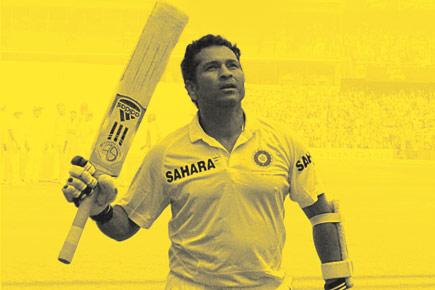
A sum of £50 (Rs 5,106) might sound like a lot of money to pay for a sports book but the latest issue of Wisden, the 151st edition of the Cricketers’ Almanack, is actually priceless. At the very least, it is a collector’s item for admirers of Sachin Tendulkar who adorns the cover.

The Nawab of Pataudi (seated middle) was captain of his school, Winchester College, in 1959 his record of 1,068 runs in a season stands to this day
“This was our last chance to put Sachin Tendulkar on the cover,” explains Lawrence Booth, the English journalist who has been Wisden’s editor since 2012. Booth is the 17th to hold the post since ‘the bible of cricket’ (Alec Waugh’s description in the 1930s) was first published in 1864 by an English cricketer named John Wisden.
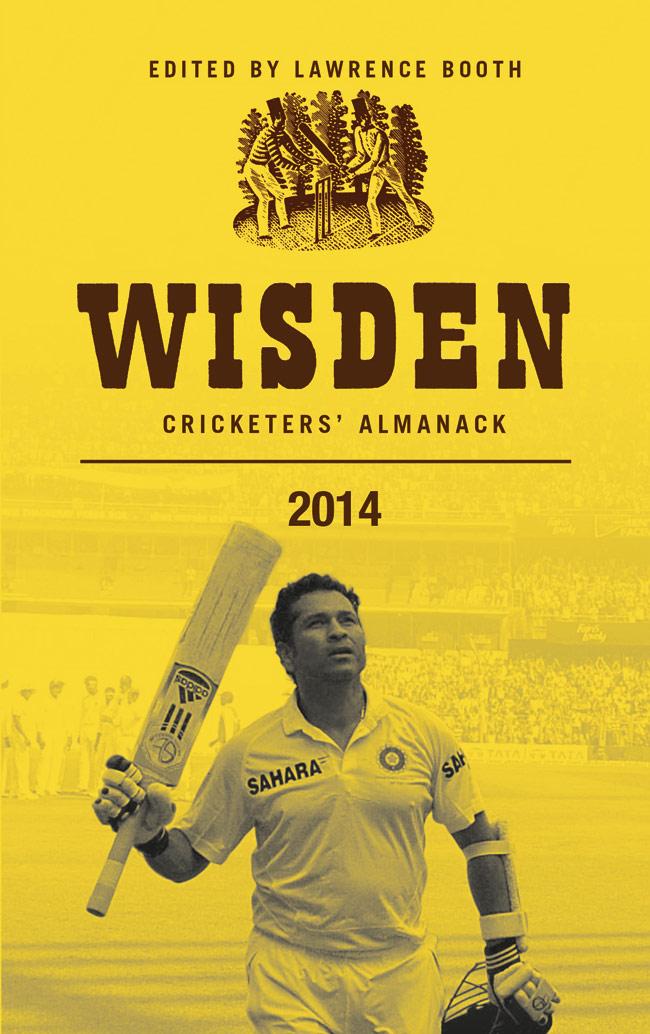
Sachin Tendulkar on the cover of Wisden 2014
That makes Wisden the world’s most famous sports reference book. “The image we chose (of Tendulkar) was too good to ignore,” adds Booth, who has been to India several times as a cricket correspondent for the Daily Mail for whom he also works.

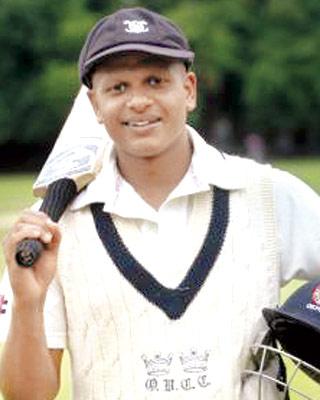
Lawrence Booth, editor of Wisden and Samridh (Sam) Sunil Agarwal hit 313 no for Oxford v Cambridge, a record
“It told a story on its own: a near-deity glancing heavenwards as he contemplates the start of a new life after 24 years of being adored by the public - some of whom can be seen in the crowd behind him. Everything about the decision felt right.”
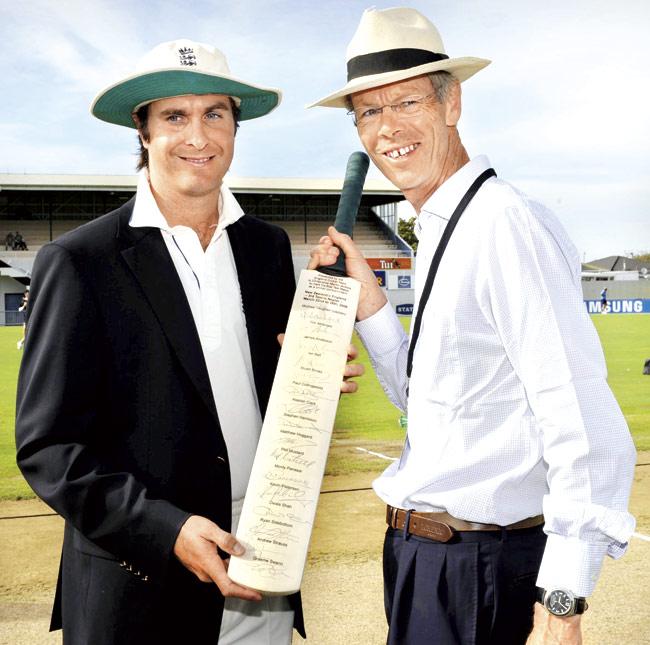
Christopher Martin-Jenkins (who was universally known as ‘CMJ’) (right) gets a signed bat from former England captain Michael Vaughan
Critical
Booth is severely critical of the way world cricket as well as the Indian Premier League (IPL) are allegedly manipulated by the financial muscle of the Board of Control for Cricket in India (BCCI) and its on-off president, N Srinivasan. “The IPL isn’t ‘wrong’, as such,” comments Booth in an interview.
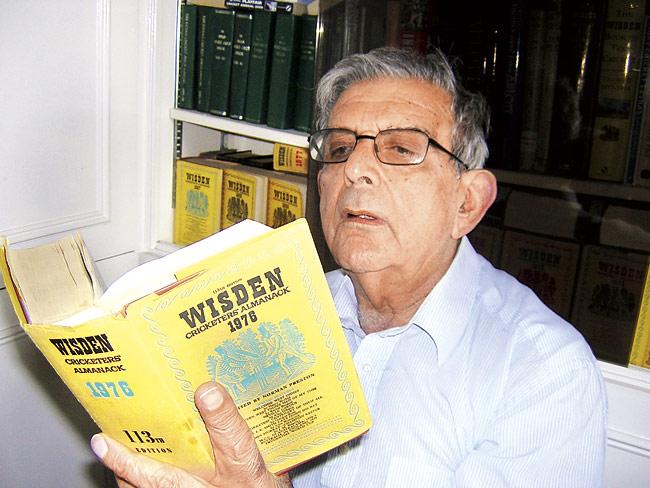
Dicky Rutnagur with an old copy of Wisden
“As I keep saying, Twenty20 has an important part to play in cricket’s global ecosystem. But if you turn a blind eye to the management of a tournament in which people are involved principally to get rich, you shouldn’t be surprised if things get out of hand.
From its very inception, the BCCI sanctioned a troubling conflict of interest by allowing Srinivasan to own a franchise while holding a senior board post, and everything has gone from there. My objection to the IPL is that no one has been guarding its integrity. I don’t feel vindicated by the Supreme Court’s insistence that Srinivasan step down as BCCI president, but I’m surprised he didn’t go of his own accord.”
The current edition of Wisden, with 1,584 pages in fine print, has enough facts and figures from all over the world to keep cricket lovers engrossed for many monsoon afternoons. Forty pages are allocated to school cricket in the UK. “School cricket is tremendously important,” emphasises Booth in the interview. “It’s a nation’s chance to get youngsters hooked on the game before other sports claim their attention.
This may not be a problem in India, but it’s a huge issue in England, where football reigns supreme and rugby is vying for second place with cricket.” Whatever Booth’s reservations about the BCCI, he is generous in recognising the joy that Tendulkar brought to the game. His retirement last November at the age of 40 was given acres of space in British national newspapers.
In his preface, Booth writes: “At a time when cricket is in danger of becoming a playground for men in suits, it’s a pleasure to point out that the largest chunk of our comment section is devoted to a man who was more interested in cover drives...he encouraged cricket lovers to recall gentler times.”
Wisden carries two articles on the former Indian batting genius — ‘Sachin, the bringer of joy’, by Tunku Varadarajan, a former editor of Newsweek, and ‘The god of small things’, by Aakash Chopra (who played “10 Tests between 2003 and 2004, but batted with Tendulkar for only 26 balls”).
There is a piece on ‘Brand Sachin, Giving India a boost since 1989,’ by Richard Gillin. There is a section headed, ‘Sachin Tendulkar, World celebrity: How the media loved him’. And to round off, a couple of pages are devoted to Tendulkar’s statistics. The pages on Indian Cricket, 2013 are entitled, ‘In Sachin’s shadow’.
Booth was present for Tendulkar’s final innings at the Wankhede which he calls: “Thank you and good night.” In ‘Notes by the Editor’, Booth observes in ‘The setting of India’s son’: “Tendulkar played Test matches in front of the most demanding fans in the world for 24 years.
If further proof was required of just how astonishing this was, it came at Perth in December, when for a few moments one (Alastair) Cook and one (Michael) Clarke added up to exactly one Tendulkar: 200 Test caps, 15,921 runs and 51 hundreds.” To that has to be added Tendulkar’s 18,426 runs, including 49 hundreds, in One Day Internationals (ODIs).
It is a truth universally acknowledged that statistics are no replacement for actually being present at a match, to experience the evocative smell of cut grass and hear the sweet sound of leather on English willow. But statistics can be revealing, as with Virender Sehwag, today discarded by his country, but in his day probably the most devastating batsman in the world.
It may be that because Tendulkar’s flame burned so brightly that others appeared to be in the dark. Sehwag has two triple centuries in Tests while no other Indian has even one. An when it comes to getting the fastest double centuries, Sehwag occupies the second, third, fourth, ninth and 11th places with 168, 182, 194, 222 and 237 balls - Nathan Astle of New Zealand is first with 153 balls. And who should have the highest ODI score? It’s Sehwag, Wisden notes, with 219, bettering Rohit Sharma’s 209 and Tendulkar’s 200 no (not out).
Figures
Among the highest scorers in first class cricket last year was Cheteshwar Pujara of India, who hit two triple centuries and two double centuries (352 for Saurashtra v Karnataka; 306 no for India A v West Indies; 269 for Saurashtra v Tamil Nadu; and 204 for India v Australia in the 2nd Test in Hyderabad).
Another Indian, Shikhar Dhawan, is one of Wisden’s “five cricketers of the year” In England, in the Oxbridge “Blues” match last year, Agra-born Oxford skipper, Samridh (“Sam”) Sunil Agarwal, scored 313 no against Cambridge, thereby beating the previous record, 247 by Delhi-boy Salil Oberoi, for Oxford, in 2005.
The latter got a note of congratulations from the late Mansur Ali Khan, the erstwhile 9th Nawab of Pataudi, whose father, the 8th Nawab, established the record, 238 no, again for Oxford, way back in 1931.
Rutnagur
Wisden carries numerous obituaries of those who passed away in 2013, among them the doyen of Indian cricket writers, Dicky Rutnagur — he kept a collection of old Wisdens close to hand in his Pimlico flat. Rutnagur, who came to the UK from Bombay and wrote about cricket, squash and badminton for The Daily Telegraph from 1966-2005, died on June 20, aged 82, and merits an affectionate obituary.
Rutnagur’s copy, which appeared under the byline, ‘D J Rutnagur’, was straight, factual and with few frills. “The restrictions largely deprived readers of his excellent cricketing judgement. In person, he was never bland: a press box with Dicky in it was always full of cigarette smoke, chat and mischief, with whisky afterwards.
There would be fits of rather comic irritability, directed at ‘the bloody subs’ or the copy-takers or simply bad cricket. Though the annoyance would soon dissolve into guffaws, he took the game seriously and expected it to be played correctly and well.
His son Richard appeared for Oxford in the 1985 and 1986 Varsity matches. There is a longer obit on Christopher Martin-Jenkins, who died on January 1, aged 67. He was cricket correspondent of The Times and before that The Daily Telegraph and was part of the team of commentators on TMS (Test Match Special) on BBC Radio 4.
He was also president of the MCC. It is intriguing to discover: “He would greet adversity of all kinds with swear words of his own invention: “Oh Captain Carruthers...Fishcakes and buttercup pie!... Bishan Singh Bedi!... Billingsgate Harbour!... Schubert!... Fotherington-Thomas!”
Memories
The Scottish-born captain of England, Mike Denness, who died on April 19, aged 72, will be remembered in India only for his actions in penalising six Indians while officiating as the International Cricket Council (ICC) match referee in South Africa in 2001.
The six were Sachin Tendulkar (ball tampering charges); Virender Sehwag (excessive appealing); Sourav Ganguly (inability to control his players’ behaviour); Harbhajan Singh (excessive appealing); Shiv Sunder Das (excessive appealing); and Deep Dasgupta (excessive appealing). “The actions of the match referee in handing punishments to six players from one team was unprecedented and the matter is still viewed with controversy in India,” is Wisden’s account of the affair.
Immortal
There are many other lesser known cricketers who, ironically, live only because their obits appear in Wisden. Kalyan Mitter, who died aged 77 on August 16, played mainly for Bengal. Munawwar Ali Khan, who died on October 21, aged 88, was a tall swing bowler who played three unofficial internationals before Pakistan were elevated to Test status in 1952. His shipping company would not give the poor fellow leave of absence so he missed out on Pakistan’s inaugural Test series in India in 1952-53 and the trip to England in 1954.
Santosh Lal, who died on July 17, aged only 29, of pancreatitis, “was an all rounder for Jharkhand (formerly Bihar), scoring 63 against Tripura in December 2006. But his greatest legacy was the whirling helicopter shot later perfected by Mahendra Singh Dhoni, a state team mate. On hearing of Lal’s illness, Dhoni — a friend since childhood — arranged for him to be airlifted from Ranchi to Delhi for specialist treatment but it was too late.”
There was 22-year-old Zulfiqar Bhatti, who collapsed after being hit on the chest while batting in a club game in Sukkur in Pakistan on December 18. Doctors made every attempt to revive him “but he breathed his last on the pitch”.
Future
The dozens of British public schools mentioned in Wisden are probably nurturing the stars of tomorrow. At Tiffin School last year, “Vinay Samtani hit two centuries just a couple of weeks after his 15th birthday. Another 15-year-old, Bashir Bhatti, claimed an impressive 45 wickets with his left-arm spin (he was the country’s joint top wicket taker, sharing the honours with F Baig of St Edward’s School, Oxford).”
Repton School had a “magnificent season”, the performances of captain Nitish Kumar were “vital”. His aggregate was 909 runs for 60.60 and he also took 34 wickets at 13.79, including eight for 11 against the Free Foresters, the best figures in the country. Felsted School had a rewarding season, too, R Husain hit most runs (936 at 55.05).
At Winchester College, incidentally, the Nawab of Pataudi’s 1959 record of 1,068 runs at 71.20 still stands. He eclipsed the 1919 record 997 runs at 66.00 - that had been established at Winchester by Douglas Jardine, later, the England captain who insulted his father, the 8th Nawab, part of cricket folklore faithfully tabulated by Wisden for avid followers.
Wisden Cricketers’ Almanack is published by John Wisden & Co, an imprint of Bloomsbury Publishing. Price: £50.
 Subscribe today by clicking the link and stay updated with the latest news!" Click here!
Subscribe today by clicking the link and stay updated with the latest news!" Click here!









